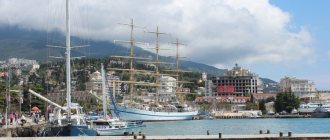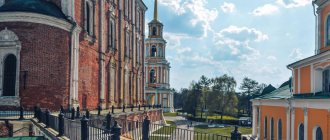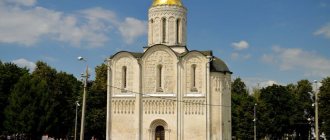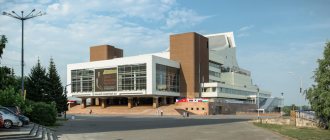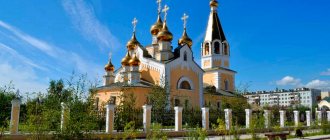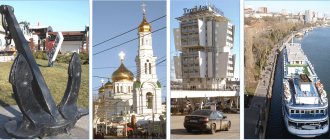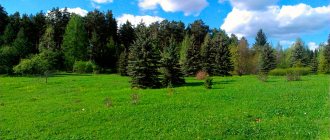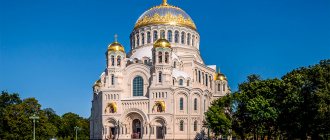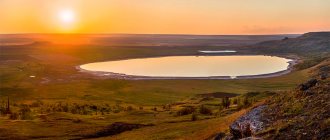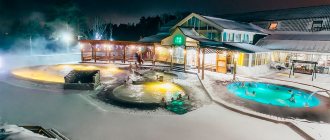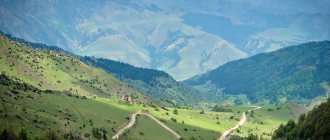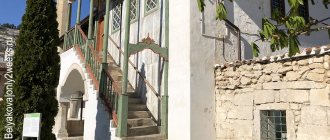Observation helipad
The next notable Samara place is located far from the center, in the village of Upravlencheskiy. This is the so-called “Helicopter”, an observation deck from which a truly magnificent view of the Volga, the islands and the far opposite bank opens.
Previously, this place was chosen by observers of log rafting along the river, then it was called “Sanina Polyana”. Then, in Soviet times, a real helipad appeared here, where the aircraft of the famous designer Nikolai Dmitrievich Kuznetsov landed. The plant named after him is still one of the largest in Russia in the production of aircraft and space engines.
In 2000, the place found a new life: the site was landscaped to attract tourists and local residents to admire the beautiful panorama. The area, consisting of the upper and lower levels, was cleared of debris, lighting was provided, and a cafe and benches were installed. Now it is the pride of Samara, attracting weddings, families with children, and tourists. Photography enthusiasts can take great shots here.
In 2022, Helicopter became even more beautiful: it was re-landscaped, the slope was strengthened, various benches, swings, a playground were installed, and flowers were planted. Now you can comfortably spend the whole day here. Those who want to see the other shore in detail can use binoculars. There is parking nearby, so you can freely come by car.
- Address: st. Vetvistaya, 1
- Opening hours: daily, 24 hours a day
- The entrance is free
Zhigulevsky brewery
The next place is a must-visit for beer lovers. This is the Zhigulevsky brewery, which produces the Zhigulevskoye beer that has long become a brand. The plant was built back in 1881; it is one of the oldest in the country. The brewery is located in an ancient building, recognized as an architectural monument and an object of cultural heritage of Russia.
Despite this, it is not at all difficult to get inside the plant. Just buy tickets near the main entrance, and you will find yourself on an hour and a half excursion, which takes place daily. Visitors will get acquainted with all production stages in operating workshops, learn what stages beer production consists of, from fermentation to bottling the finished drink. And then guests will be offered to taste several types of foamy drink.
And next to the walls of the plant there is another favorite spot for Samara residents - the Na Dne beer bar. Fresh beer enters it directly through pipes, bypassing the bottling stage. And if once it was a modest beer hall, now it is a modern-looking two-story establishment, still loved by guests and Samara residents for its delicious beer, proximity to the Volga and democratic atmosphere.
- Address : Volzhsky prospect, 4
- Website: samarabeer.ru
Leningradskaya street
Most million-plus cities in Russia have a pedestrian street beloved by locals and tourists. Samara is no exception: Leningradskaya, also called the “Samara Arbat,” became such a street. Located in the historical center, it stretches for 1.7 km and reaches the Volga embankment. Once it was called Panskaya and was built up not only with mansions, but also with merchant shops. During Soviet times, beautiful department stores appeared there, then restaurants and boutiques arose, but many old buildings have survived to this day. The most striking among them are the house of the merchant Golovin and the house of the architect Mashkov.
For the most part, you can walk safely on the streets without fear of cars. Wide, green, it is also a center of attraction for Samara’s creative people: you can often meet artists or street musicians here.
The most striking element of Leningradskaya is the sculptural composition “Uncle Styopa - Policeman”. Dedicated to the hero of the same name from the poem by Sergei Mikhalkov, it appeared in the city recently, in 2015, on the occasion of the 80th anniversary of the poem. A six-meter bronze figure in a pre-war police uniform rises above the same bronze children, which the little Samarans love to join. The author of the sculpture is the famous Zurab Tsereteli.
In the features of Uncle Styopa there is a similarity with the Samara police sergeant Oleg Petrovich Malinin, whom many townspeople respected.
- Address: Leningradskaya street
Iversky Convent
The Orthodox Iversky Women's Monastery is the only women's monastery in Samara, which was founded in the mid-19th century and named after the icon of the Iveron Mother of God. At one time it was a significant religious center, a point where pilgrims came in large numbers. Under the USSR, it was closed and partially destroyed, including the bell tower, as well as the large Assumption Cathedral.
In the early 90s, the monastery was recognized as a historical monument, handed over to believers and began to be revived. Now the holy monastery has been restored and is functioning; on its lands the burial place of the Samara governor, an honorary citizen of the city, Peter Vladimirovich Alabin, was found. The Iversky Monastery is a very beautiful complex of buildings, mostly made of red brick with white edging. It is located on the hills overlooking the Volga and from the river, in turn, its walls and golden domes are visible.
Despite the fact that there are busy highways around, the interior is quiet and green, where parishioners can visit the central church of the monastery.
- Address: Volzhsky Prospekt, 1
- Opening hours: daily 6.00 to 20.00
- Free admission
- Website: iverskiy.rf
Train Station
One of the calling cards of Samara is the railway station, which is considered the highest in Europe. It was erected in 2001 on the site of an old building that was built in 1876. A very stylish and unusual building can be seen from afar; together with its spire, its height is more than 100 meters. At night, the walls and dome of the station glow, the blue upper part is especially noticeable.
The modern station is thought out and created taking into account the convenience of passengers. The building itself houses waiting rooms, a hotel, a service center and support services. The highlight of the station is its observation deck, a balcony around the dome, where anyone can buy a ticket and go up. Viewers have a panoramic view of the city and can see two rivers, Samara and Volga. Exhibitions or concerts are often held inside the station.
The station square is called Komsomolskaya, there is a parking lot there, and the area is decorated for the New Year. The area with the platforms is connected by a long, wide tunnel. In 2012, a sculpture dedicated to the character of the film “Beware of the Car”, Yuri Detochkin, was installed on Komsomol Square. Two meters tall, with the face of Innokenty Smoktunovsky, he stands among the townspeople as if he had just returned home. The sculpture was installed in honor of the 85th anniversary of the film’s director, Eldar Ryazanov.
- Address: Komsomolskaya square, 1
- Opening hours: daily, 24 hours a day
- The entrance is free
- Website: samara.dzvr.ru
Roman Catholic Church of the Sacred Heart of Jesus
Samara is a multinational and multi-religious city. Orthodox churches coexist with a mosque, a church, a church... A huge red brick building on Frunze Street is a Catholic church, one of the calling cards of the city. Graceful, as if rushing into the sky, with high sharp spiers, it is visible from afar and can leave few people indifferent. The temple was built in the neo-Gothic style and has no analogues in Samara.
The Church of the Sacred Heart of Jesus was built by the Polish community and consecrated on February 12, 1906. Until the 20s of the 20th century, it received believers, after which it was closed and looted. But most of the majestic building survived, and in 1941 the Samara Museum of Local Lore was opened there. Where prayers had recently been heard, excursions were now held, household items and bones of extinct animals were placed.
But in the early nineties everything changed again, and the temple was transferred to the Catholic community. It was put in order, re-consecrated, and crosses were placed on the spiers. Now services are held there, there is a Catholic library, a parish newspaper is published and an electric organ sounds. The inside of the church is as beautiful as the outside: two rows of light columns, stained glass windows, benches and figurative moldings. The temple building is still quite young, but gives the impression of antiquity.
Concerts of sacred and classical music are organized here for everyone. You can visit the church either on an excursion or individually. You can attend Mass, regardless of religion, the main thing is to follow the rules of behavior and not disturb those present.
The Samara Catholic Church is recognized as an architectural monument and is under state protection.
- Address: st. Frunze, 157
- Opening hours: the temple is open daily, except Mondays, from 9.00 to 13.00 and from 15.00 until the end of evening services
- Website: catholicsamara.wordpress.com
Park named after Yuri Gagarin
One of the most interesting Samara parks is named after Yuri Gagarin. Once it was located on the outskirts, but with the growth of the city it “moved” closer to the center. This recreation area appeared in 1976; it is not too large - 39.3 hectares, but with a territory varied in functionality. There are sports areas, attractions, and green areas under trees. There is a canal through the park that ends in a lake: here you can rent a boat or catamaran, or just stand on the bridge looking at the water. The most noticeable feature of the park is its entrance, white concrete structures with carved circles that look like pieces of cheese.
Both children and adults will find entertainment here. There are swings and carousels for both kids and extreme sports enthusiasts. A 55-metre Ferris wheel was recently installed and operates all year round thanks to its heated, enclosed cabins. At night, the wheel is illuminated and can be seen from afar.
Another noticeable place in the park is the island with cannons. Next to it is a shell-shaped stage. There is a football field and courts for basketball and volleyball, it is planned to reopen the karting area, and in winter the townspeople go skiing. The park has many cafes and kiosks, and hosts festivals, celebrations, dance and sporting events.
The local trees, oaks, spruces and maples, have long been chosen by squirrels who are not afraid of people. Ducks swim along the canal and lake; swans used to live in a special enclosure. A special “resident” of the park is a three-hundred-year-old oak tree; it is fenced and protected by the state.
Also on the territory there is a bust of Yuri Gagarin and an obelisk to the victims of political repression.
- Address: Soviet Army, 181v
- Opening hours: daily, 24 hours a day
- The entrance is free
Volga Region Museum of Railway Equipment (Locomotive Museum)
The museum has been operating in the provincial center since 2010 and occupies more than one and a half hectares. Railway students from the Samara State Transport University are studying the trains and locomotives of previous years.
The territory of the institution is a former training ground for railway troops. During the Great Patriotic War, trains carrying evacuated industries arrived here. And now guests can see the heated carriage, in which military furnishings, including the kitchen, have been preserved.
At the entrance there is a building that is an exhibit in itself - this is the former Dashkovo station station of the 19th century, the prototype of which was previously located in the Penza region. Inside there are numerous exhibits: railway antiques, documents, models, old photographs, and a mannequin in the uniform of a station employee.
Outside on the rails there is an extensive fleet of equipment from different years: an old steam locomotive, an electric train, passenger and freight cars, a transport motorized railcar - more than 60 units in total. Some exhibits are available for viewing from the inside. Near all of them there are signs with a story about the object. The museum offers tours.
- Address: st. Litvinova, 332, lit. A
- Opening hours: Tuesday-Sunday from 09:00 to 17:00
Samara embankment
Samara embankment is rightfully considered one of the most beautiful in Russia. It is not for nothing that it is called the calling card of the city, and it is best to start getting acquainted with Samara from here. The creation of the embankment began in the mid-30s of the 20th century. Its length is more than 4 km along the Volga bank. There are currently four queues available for guests and local residents, with a fifth in the pipeline. Long promenades among flower beds and lawns, under the canopy of trees (chestnuts, spruces and even palm trees) are adjacent to sandy beaches, open to everyone in the summer season. There is a fountain with light and music on the embankment. Opposite are the green banks of the Samarskaya Luka National Park, where you can go from several piers and the River Station.
Those walking along the embankment can visit cafes and restaurants, buy souvenirs, and taste ice cream. Those who wish have the opportunity to rent roller skates or scooters - there are separate paths for this type of transport. There are playgrounds for children and sports grounds for adults. The embankment is one of the traditional venues for city festivals. There are many sculptures and art objects here, the largest of which is the snow-white “Rook” stele, installed in 1986 for the 400th anniversary of the city of Samara.
Also attracting attention is the sculptural composition “Barge Haulers on the Volga”, installed on September 11, 2014, in the year of the 170th anniversary of the birth of the Itinerant artist Ilya Repin. The great Russian artist created his masterpiece in the Samara province, in the village of Shiryaevo. The sculpture dedicated to the painting is a bronze frame in which barge haulers pull the strap. And behind them you can see the Volga and the far bank.
The huge monument to Prince Zasekin is another prominent place on the embankment. The monument faces the center of the old fortress city, which was once founded by the governor. In the hands of Grigory Zasekin is a banner with the image of the Savior Not Made by Hands.
Another interesting sculpture is dedicated to Comrade Sukhov from the film “White Sun of the Desert.” It is located between Leningradsky and Nekrasovsky descent. Red Army soldier Fyodor Sukhov, the main character of the film, says: “Now, I’ll get to the Volga, and then it’s just a stone’s throw to Samara.” And it seems that he has really returned to his homeland and is now standing among the people walking.
Avant-garde sculptures are also installed on the embankment, for example, the composition “Cradle of Humankind” as the personification of the connection between the Earth and humanity. It is located on Pervomaisky Descent. You will see the figures of two people intertwined with each other and forming one whole - humanity covering the globe. There is also a Bench for Lovers: its seat is designed in a special way, inclined in the center, it brings those sitting down together. And the back is decorated with a big heart.
- Address : St. Alexy embankment (1st stage), Alley of the Newlyweds (2nd stage), st. Maxim Gorky, 113 (3rd stage), st. Lesnaya (4th stage)
Strukovsky Garden
On the banks of the Volga is the oldest of Samara’s parks – Strukovsky Garden. There was once a forest here, the owner of which was the manager of the Iletsk salt mines, G. N. Strukov. He was the first to arrange a park area here. Since the nineteenth century, the site has had several owners. After the 1917 revolution, the park was renamed in honor of Maxim Gorky, but in the nineties of the twentieth century its historical name returned. The territory grew and was improved: the garden was fenced with a beautiful lattice, a covered stage, a fountain were built, and the paths were paved.
Now it belongs to the favorite vacation spots of the townspeople. The park itself is not too big - only 11 hectares. On one side it is adjacent to the embankment, and on the other, one of the iconic streets of old Samara, Kuibysheva Street.
Strukovsky Garden is very green: many flower beds, lawns, trees. It is multi-level, arranged in tiers, and you can get from one to another via stairs. From the upper path you can see a significant part of the territory. Just outside the entrance there is a curious fountain: two children, a boy and a girl, are holding an umbrella to protect them from water splashes. This composition appeared in the park back in the 19th century; it was removed several times, but then returned to its place.
Another striking symbol of the park is a stone grotto, at the top of which rises a golden figure of a goat, the symbol of Samara. Nearby is another fountain that resembles a waterfall. For the convenience of vacationers, there are beautiful gazebos and swings, and the lawns are decorated with wooden sculptures.
The park hosts different festivals every year: a book festival, a flower festival, and the international street art festival “Plasticine Rain.” It was in the Strukovsky Garden, colloquially in Strukachi, that the famous waltz “On the Hills of Manchuria” was performed for the first time in 1907. It is dedicated to the memory of soldiers who died in battle in the Russo-Japanese War. In this regard, in 2013 a brass band festival is being held in Samara. And in 2022, a sculptural composition was opened here in honor of this musical work.
- Address: st. Krasnoarmeyskaya, 2a
- Opening hours: daily, 24 hours a day
- The entrance is free
